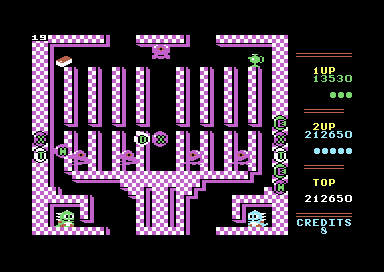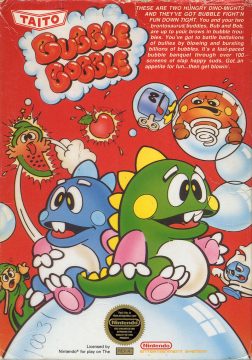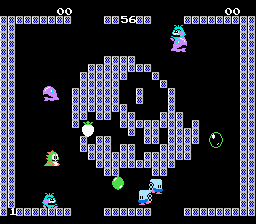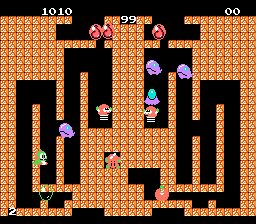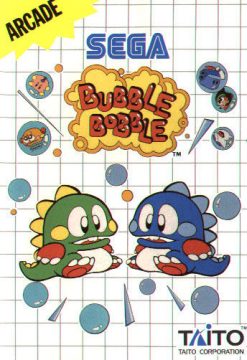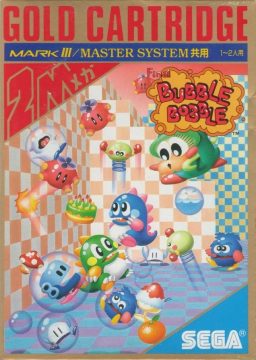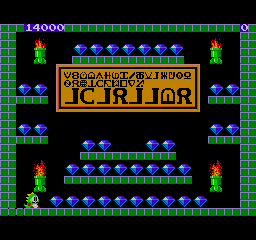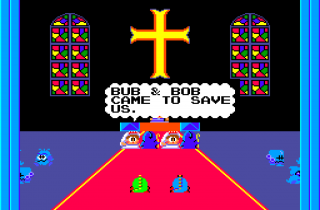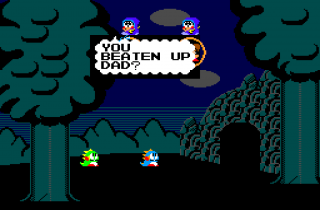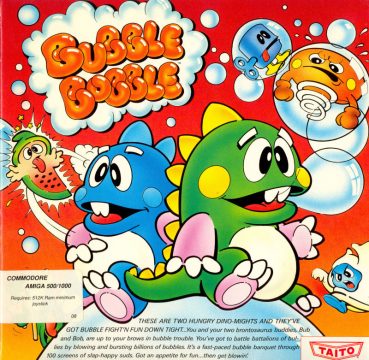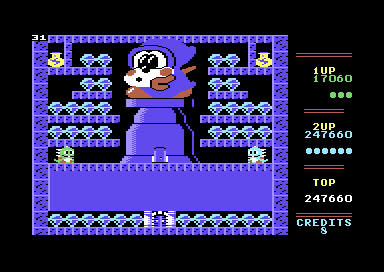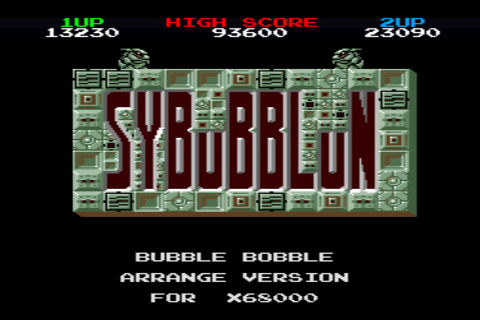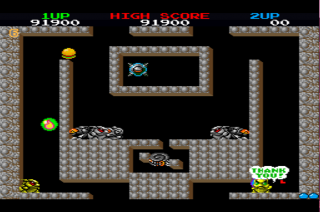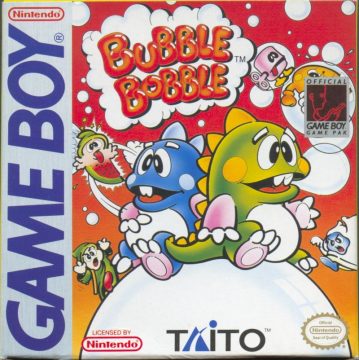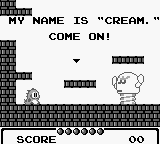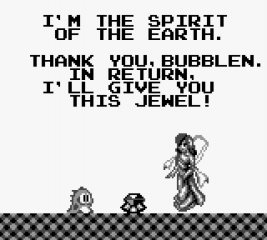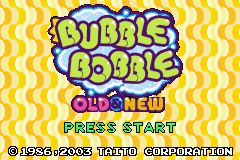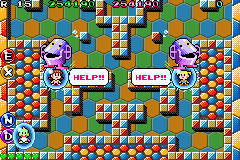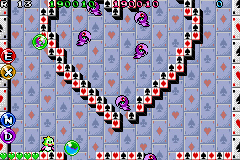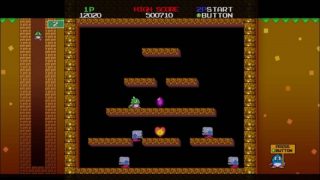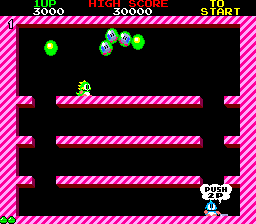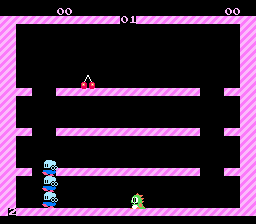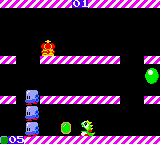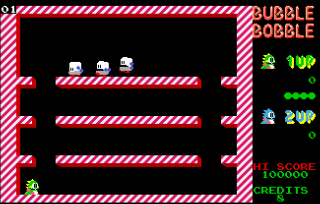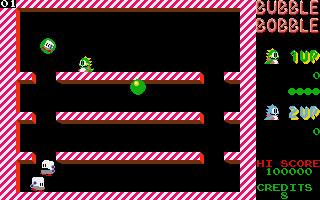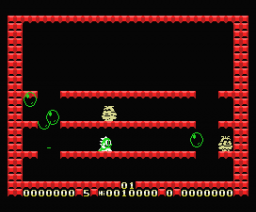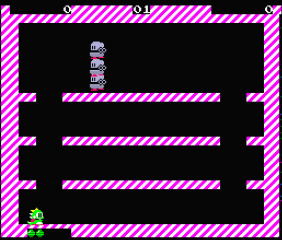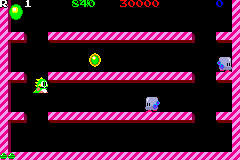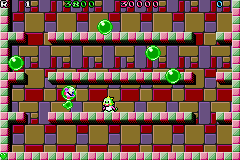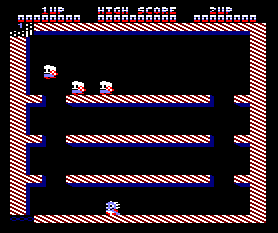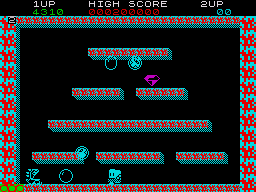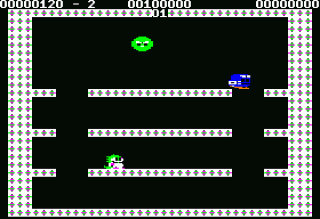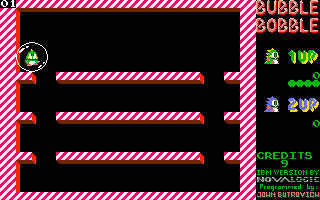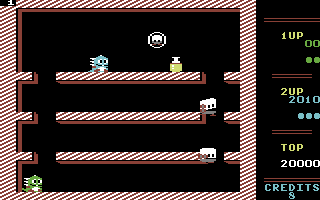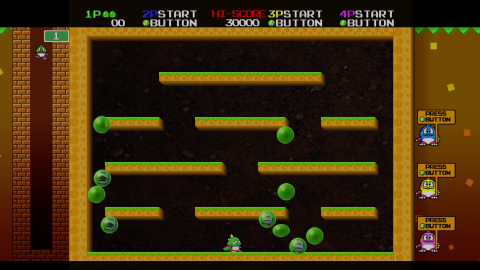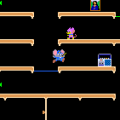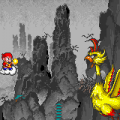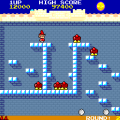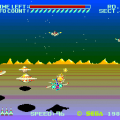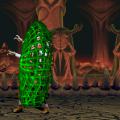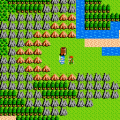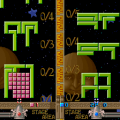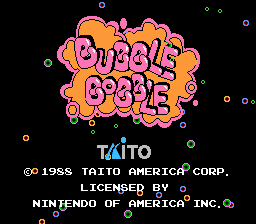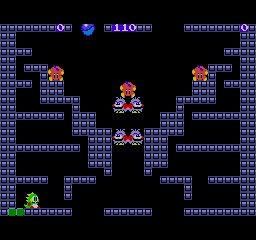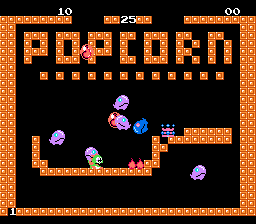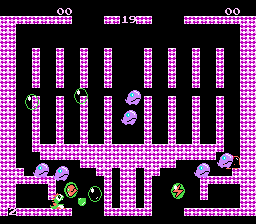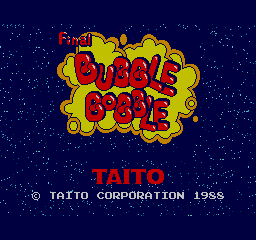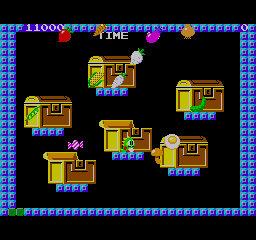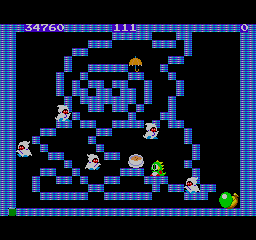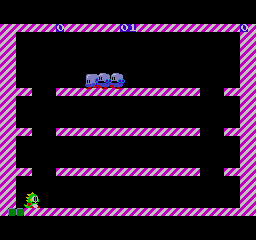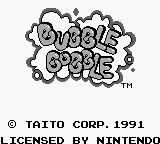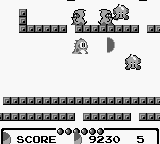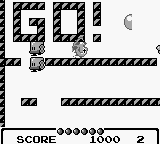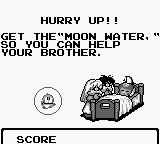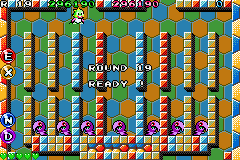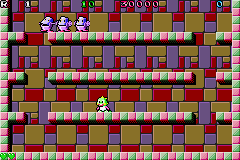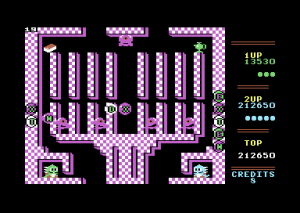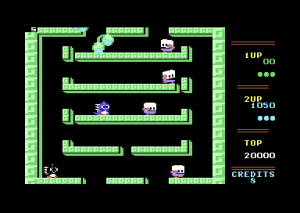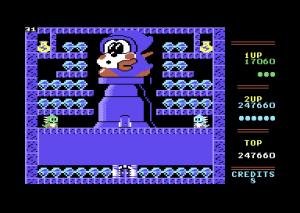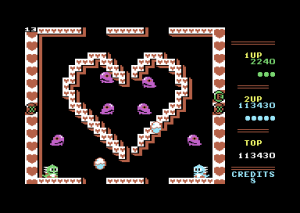Since its initial release in 1986, Bubble Bobble has appeared on platforms from the NES and Sega Master System to the FM Towns and Xbox 360. While all of these ports strove to be as close to the arcade as they could, in many cases it wasn’t totally possible based on the limitations of each platform. This was further complicated by Taito actually losing the source code to the game during a restructure in 1996. Taito itself made the ports of Bubble Bobble for the NES, Game Boy, Master System, and MSX2, while various other companies handled porting the game to other platforms. For the most part, players can expect capturing monsters, bouncing on bubbles, collecting items, and reaching the end of the game to be largely the same regardless of the system, while the major differences encountered lie in the graphical and sound quality of each one. In addition, enemies also adopted new behaviors and attack patterns in some ports.
That said, certain ports did possess expanded content, which is explored below.
Bubble Bobble (NES, 1988/Wii, 2007/3DS, 2013/Wii U, 2014)
The NES version of Bubble Bobble does an excellent job of mimicking the arcade experience, enabling two players to descend into the Cave of Monsters while trying to crack the convoluted ways items appear. Certain concessions have been made for console gamers as well, making the game even more accessible. Though the game still instantly ends when Bub and Bob have lost all their lives, Taito decided to add a simple five-letter password system that updates as the players progress. After being kicked out of the game the password for the appropriate level will already be entered, enabling players to quickly jump back into the action. This greatly reduces the overall difficulty by enabling players to practice stages over and over again with little downtime, compared to having to start from scratch like arcade players would if they couldn’t feed the machine fast enough.
Difficult or inescapable pits have been expanded to be more easily navigated, with the exception of the menorah-shaped floor 19 that still can’t be bubble jumped out of. Though the timing of bubble jumping from these areas is still somewhat tight, it’s much more forgiving than the arcade version.
Additional levels were also added to the game. Many of the new stages are designed to look like the monsters Bub and Bob encounter and, while cute, the quality of the experience depends on how the monsters bump around the area. The game also progresses past level 100 if players collect the new crystal ball item on floor 99. While some of these stages – labeled A0 to B3 – are just copies of the arcade stages the monster-themed floors replaced in early levels, some are brand new. Strangely, secret rooms have been cut from the game entirely along with the associated music and cryptic language. Super players from the arcade would have likely been dumbfounded when they reached floor 20 without dying once and went unrewarded for their efforts.
There’s still some downsides to this port, however. The graphics and sound have taken a hit, which is unsurprising considering it moved from the arcade to an 8-bit console. Bub and Bob are also less animated – neither brother squishes against a wall when they are stuck against a bubble, and their death animations lack the halo of stars circling their heads. These are minor quibbles and have no real impact on the quality of the game itself.
Forging past floor 99 is a pain, though. The level is entirely the same as the arcade version and tasks players with performing tight bubble jumps, evading dangerous Monstas, and clipping through walls to defeat every enemy. Taito took this already stressful level and made it worse by adding the crystal ball item needed to reach the good ending. Both players immediately have to rush through the level, with the player on the right tasked with grabbing the item and the player on the left clipping through the wall to pass through the secret door that appears after the crystal ball is collected. If either player botches the effort they’ll have to restart the entire level in order to progress. It’s the sort of task that’ll either have couples griping at one another or exchanging weary glances and wondering if this is how they really want to spend their evening together. (Speaking from experience).
Overall, the NES port is a faithful rendition of the arcade game and at the time was one of the best options for playing Bubble Bobble at the time. These days arcade ports of the original are easily accessible, though trying out the NES version still has its charm.
Final Bubble Bobble (Master System Japan, 1988) / Bubble Bobble (Master System Europe, 1992) / Bubble Bobble (Game Gear, 1994) / Dragon Maze (Sega Master System South America, 1994)
One of the best early ports released, Final Bubble Bobble matches the original arcade game as closely as hardware limitations allow while also adding its own spin to the formula. Final Bubble Bobble is nearly mechanically identical to its source, featuring bubble jumping, kissing (referred to as biting in the European manual), and geometric exploits like passing and shooting through walls. It also follows the obtuse item spawn system the arcade release is known for, giving each playthrough its own relatively unique flavor.
Final Bubble Bobble isn’t just a simple port, however. Super Mode has been eliminated from the game, and instead features all 200 levels from start to finish. New items are also added, such as a blue crystal chalice that generates a devastating black hole that defeats all enemies, a book that freezes all enemies and turns them into high-point-value ice cubes, and a peacock feather that summons a killer fairy that rotates around the player for several levels. Though the chalice and book are relatively simple kill-all items like likes of the thunder and water cross, the feather is a tremendously powerful item that can make some of the most difficult levels in the game easier through its long life-span and ability to strike enemies hiding behind walls. It’s so strong, in fact, that it trivializes certain puzzle-centric levels, which greatly improves the flow of the game.
New collectibles can be found in Final Bubble Bobble which are critical to unlocking the final 100 levels of the game. Secret rooms in the original game could only be accessed by reaching levels 20, 30, and 40 without dying and only awarded bonus-point items and a coded message. The secret rooms in the initial 100 floors Final Bubble Bobble are far more numerous and, in addition to the usual bonus points, also contain three crystal balls necessary to continue the game. Secret rooms beyond level 100 contain other special magical items necessary to progress through the rest of the game such as a magic key needed to open the later secret rooms, a candle that enables players to see in pitch black rooms, and three magic mirrors to reach the end of the game. This scavenger hunt concept would be later used by Bubble Bobble’s direct sequels Bubble Symphony and Bubble Memories, both to their benefit and detriment.
The final new additions to the game comes in the form of mid-bosses and additional stage layouts. Previously the only major boss was the giant Drunk enemy at the end of the game, yet Final Bubble Bobble adds brand new giant versions of the rock-throwing ghost monster Mighta and the fireball-vomiting Hidegon at certain points of the game. New stage layouts are also in the game, though they’re typically designed in the shapes of monsters or symbols.
While Final Bubble Bobble has everything needed to be as good or perhaps even better than the original, several missteps keep it from being as such. Bubble Bobble was always designed with couples in mind, and adding a second player was conceptually supposed to make the game more enjoyable. Final, however, is very much designed with a single player in mind and this is frequently to its disadvantage. The final boss battle in the arcade version was perhaps its weakest moment due to the spammy nature of the boss’s projectiles and high likelihood of both players stunning each other with their lightning bubbles. All the bosses in Final are just as bad as those in the arcade and, worse still, only a single player can challenge the Mighta mid-boss. A single fire cross spawns at the top of the stage during that fight and is the only way to damage it. This requires one player to grab the cross while the other player does their best to avoid getting killed.
Players have their own separate inventories which further complicates matters. During the course of the game both players need the crystal balls found in secret rooms to progress. If one player loses all their lives during the fight on level 100 and is in possession of one of those items, the surviving player is treated to a bad ending after winning the fight as they are not in possession of all three. Additionally, the magic key is needed to open secret rooms past level 100, and if the owner of the key loses all their lives the other player cannot enter those doors. Finally, if the player holding the candle loses all their lives then the surviving player has to complete the following levels nearly blind. It’s a rather strange design choice which ultimately requires two players to decide which one of them will be the “mule” and do everything they can to ensure that player’s survival.
Furthermore, reaching the true ending of the game doesn’t require a second player to be present, unlike the arcade original. While on the one hand this definitely makes seeing the ending easier, it also strikes at the core concept of the original.
Final Bubble Bobble also becomes extremely difficult as the game progresses and at points feels downright mean-spirited. Monsters in the arcade version could break free from bubbles more easily depending on how far into the game players were, but they typically would remain trapped for at least a second. Final Bubble Bobble features many levels where enemies can break free after half a second, forcing players to attempt multiple risky “kisses” or use special bubbles floating about the stage to defeat them. While this plays to the puzzle-like nature of the game, many of these same stages often swarm players with monsters before they have a chance to assess what is happening, leading to a lot of cheap deaths. These issues – combined with a shared inventory critical to progression – can result in a two-player game ending multiple times in short order.
The methods to reveal secret rooms are also extremely unusual which is made worse by the fact that hints to their existence will only appear with the use of two codes that are only available and usable in the Japanese version of the game. Revealing secret rooms requires players to act in ways they typically might not during normal gameplay, such as killing all enemies in the stage only using fire bubbles or avoiding killing any enemies until “Hurry Up!” appears, giving the game a distinct Tower of Druaga feel. On its own this wouldn’t be a bad thing if hints were readily available. Unfortunately for Japanese players, they have to reach level 99, find the secret room of that level, and then decrypt the message in the background to learn the code to reveal hints from the first 100 levels. The same process has to be repeated for the second half of the game; reach level 199, find the secret room, decrypt the message, and input the code to receive hints for the latter 100 levels. Everyone else is out of luck – the European manual hints that discovering secret rooms is critical to completing the game but reveals little else.
Final Bubble Bobble is certainly a superior home conversion of the arcade game, yet its harsh difficulty, strict inventory system, and secretive scavenger hunt elements make it harder to enjoy. Despite that fans of Bubble Bobble should give it a shot – but ideally as a single player experience while following a guide.
Bubble Bobble – Commodore 64, Apple II, Amstrad CPC, Commodore Amiga, ZX Spectrum, MSX, MSX2, IBM PC (1987, etc.)
Bubble Bobble on the Commodore 64 is a remarkably solid port. It retains the usual method of popping bubbles through Bub and Bob’s fins and spines, the cryptic methods of obtaining items, and features 100 stages of the arcade original. Though there are some minor differences, such as the coded messages not appearing in the secret rooms, Commodore 64 players could play their version and have their experiences easily translate to the arcade version if they played it immediately afterward.
For the Spectrum ZX port, the most striking aspect of it is its graphics, which makes it look like Bub and Bob came out of a can of SpaghettiO’s. The color palette also tends to be pretty garish, and some levels even look like they’re covered in blood. Some may still find it cute in its own way, which is particularly important given that charm is an important part to the Bubble Bobble experience. The actual gameplay is largely preserved and items continue to appear through complicated means, though enemies tend to act differently than in other games. The stone-throwing Mighta enemies will rapidly fire projectiles when they see the player, compared to pausing a moment and only firing a single projectile. The Skel Monstas somewhat differently by sitting in one place longer than most versions and then suddenly lunging to a single point in a straight line faster than in other ports. This attack behavior makes them much more predictable and, as a result, easier to dodge. The ZX port has 80 levels, at which point it loops back to an earlier point in the game after defeating Super Drunk.
Among the early direct ports, the Amiga version is fairly close to being arcade-perfect. The graphics are nearly the same and the mechanics – from bubble jumping to kissing – also function the way that they should. The Amiga version also features all 100 levels of the original, compared to the 80 of the Spectrum’s version. The music is close to the arcade, though it also has a hefty dose of Amiga instrumentation that makes it stand out on its own. Overall anyone who became enamored with the arcade original could have picked up this port and felt right at home with its visuals and gameplay.
There are a few MSX ports, mostly for Korea. Zemina put out Super Bubble Bobble and New Bubble Bobble, while Clover put out another version just called Bubble Bobble. Taito released their own version for the MSX2 in Japan, which is close to the NES version in quality.
Sybubblun (Sharp X68000, 1990)
The Sharp X68000 was home to a nearly arcade-perfect port of Bubble Bobble. More interesting, however, is a special mode tucked away in the port known as “Sybubblun.”
Fukio Mitsuji designed Syvalion in 1988, which tasked players with navigating a large mechanical dragon through a maze using a trackball controller. The arcade featured over 100 different endings, different scenarios being selected at the start of each game, and randomized mazes, enemies, and music.
The Sharp port of Bubble Bobble pays homage to Syvalion through a special mode that can only be accessed with a secret code. Holding down the Opt. 1 Key on the Sharp’s keyboard and typing “Sybubblun” while on the title screen causes a little jingle to play. This signals the player to start the game, go to the configuration menu, and then switch the game from “Bubble Bobble” to “Sybubblun.” Doing so enables players to try out a hidden expert mode with revamped graphics, enemies, music, and a fiercely difficult series of 20 unique levels.
The most immediate difference of Sybubblun is the overhauled graphics. Bub and Bob now resemble the Syvalion dragon in their appearance and new enemy types appear as super-deformed versions of their Syvalion versions. The mechanical four-pronged Xyzolog is the first to harass the brothers with their non-lethal stunning projectiles, while leaping bipedal tank-like Armax enemies appear throughout later levels. The final level features a battle against a sprite-swapped Super Drunk which now appears as super-deformed ammonite-looking Glodloid. Some of the power-ups that appear also have new sprites, such as the rapid-fire candy being replaced with triple golden orbs – which originally appeared as point items in Syvalion.
Sybubblun tests players’ skills to the highest possible degree in each level. Level one serves as a sort of introduction with Xyzologs that sit stationary on narrow platforms and shoot harmless projectiles that stun and shove the robot brothers around. The room is also devoid of air currents, requiring players to carefully fire bubbles and perform precise bubble jumps to reach each individual enemy. The game stops playing around after this and oftentimes places all enemies in the enraged “Hurry Up” state the instant the floor begins. In other stages players must fire their bubbles in precise locations, immediately rush over, and bubble jump to higher platforms or watch how their bubbles travel along convoluted air currents to determine how they can reach trapped enemies. Power-ups are more important than ever in Sybubblun as they can mean the difference between easily clearing a floor or greatly struggling against a difficult puzzle. It’s somewhat surprising, therefore, when players reach level 20 and the boss is a simple sprite-swapped Super Drunk. While it is a bit of a relief given how difficult the lead-up is, the simple fight still results in Sybubblun ending on a flat note.
Sybubblun is an exceptionally obscure game given no other Bubble Bobble game or port to date has featured it. It’s definitely worth trying, though doing so would require the equally obscure Sharp X68000 or muddling through an equivalent emulator with Sharp X68000 keyboard support. For those that decide to play the game, be warned – the difficulty of Sybubblun is not for the faint of heart.
Bubble Bobble (Game Boy, 1991)
Not content to simply make as close to a carbon copy of the arcade original as possible, Taito decided to make the Game Boy version of Bubble Bobble almost wholly original. In this version, Bub is tasked with saving his sick brother by finding the fabled Moon Water, which is deep within the Cave of Monsters. Doing so will not only cure his brother but also return Bob to his original form. Like Final Bubble Bobble that came before it, Bubble Bobble for the Game Boy is focused on a single player experience.
Bubble Bobble for the Game Boy features 200 levels total like the arcade, but the vast majority of them are brand new and unique to this port. While there are a few stages that are similar to the arcade versions, many of them have been tweaked slightly by adding new messages – such as the popcorn skillet stage now saying “POPCORN TIME” instead of just “POPCORN” – or adding new obstacles.
Named sub-bosses appear throughout the game and, when defeated, spawn a hidden door that can be entered for a collectable that is critical to viewing the best ending of the game. Players can ignore these doors but doing so results in a bad ending. This is nearly identical to Final Bubble Bobble, though it’s nearly impossible to miss.
The graphics of Bubble Bobble are fairly similar to those of the arcade though not as animated. Bub and his foes look exactly the same here as they did in the arcade, although the stone-rolling Mightas now throw magic projectiles that look similar to planets. The Fire, Water, and Lightning Crosses are now magic crystals which is unusual considering the crosses were present in the NES version of the game.
Despite those changes this version of Bubble Bobble is much like any other. Enemies are still defeated by capturing them in bubbles and popping them, bubbles can be bounced upon, and the spawn method of special items are as byzantine as ever.
Many ports of arcade games have to confront an undeniable reality that the hardware the port is being run on often isn’t as powerful as the source. This is especially true for the Game Boy, not only because of its technical limitations, but also because of the size of its screen. For this port rather than trying to shrink everything down to a few pixels to make everything on screen viewable, Taito decided to keep the graphical fidelity of the sprites as close to the arcade as possible and instead introduced scrolling to each level. While this makes the stages feel much larger, it also means players are forced to make blind jumps to different parts of the stages where unseen enemies may await. The scrolling nature of the game also means that if a special item spawns the player may never see it. To combat this, players can hit select to pause the game and then freely scroll around the stage to see where everything is. Unfortunately this is a relatively inelegant solution that causes frequent interruptions and slows the flow of the gameplay.
Though the spritework found in this port is nice, the game suffers from heavy graphical flicker. This is particularly unfortunate considering Bubble Bobble often features a huge number of sprites on screen due the bubbles floating about. While this normally wouldn’t be anything more than an annoyance, it often makes it difficult to make out what the bonus food items or special items look like.
Despite those problems, Bubble Bobble for the Game Boy is still a worthy port of the arcade game and its password system makes it easy to pick up and play whenever the player wants. While there are better and far more accurate ports available, it’s still worth playing to see the new stages featured.
Bubble Bobble Old and New (Game Boy Advance, 2004)
Bubble Bobble Old and New merges the sensibilities of the original Gameboy title while emulating the arcade original. Players are presented with two versions of Bubble Bobble; the “old” version which is nearly arcade perfect, and a “new” version, which reuses all the original stages while adding new spritework, backgrounds, music, a stage select, and an item dictionary.
The “old” version is converted quite well. Enemy behaviors and attacks are the same as the arcade, advanced techniques like kissing and bubble jumping function as expected, and Bub and Bob’s animations are exactly the same as in the arcade. Many ports often skip the “smashing” animation Bub and Bob display when being pushed up against a wall by a bubble, the flipper waving when blowing bubbles, as well as the death animation that sees the brothers collapse to the ground while they see stars. This is all included in the “old” version, which demonstrates how dedicated the port is to the original. All 100 levels of the arcade are included in the “old” version along with the 100 Super levels after inputting a code.
Though ported extremely well, the old version isn’t without its problems. Many of the sound effects are close to the arcade, however some sounds drag on a bit longer than they should, making them sound shrill. The music isn’t particularly great, unfortunately, and leans heavily on electronic bass. Furthermore, both the “old” and “new” versions have to contend with the Game Boy Advance’s small screen size, forcing both to introduce scrolling to nearly every level like the original Game Boy game. On top of that, looping to the top of stages is jarring as the game suddenly jumps to Bub’s new position and players can expect to lose lives after making these blind jumps.
Despite being billed as the “old” version a few modern conveniences were added to improve the overall experience of the game. A stage select mode is included in this version, enabling players to pick up where they left off after losing their last life or when returning to the game after a break. Solo players can also summon a computer controlled Bob after completing the 100th floor, enabling them to see the true ending as well as to get a feel for the cooperative nature of the original game.
The “new” version of the game isn’t exactly new, but instead overhauls the graphics and music to mixed effect. It also adds an item dictionary which fills out as the player collects food and power-ups, and gives both Bub and Bob voices.
The music features a new remix of the original stage theme, which is great relief considering how repetitive the old one can get. It still has some of the unattractive heavy bass effects from the “old” version, though this is only really noticeable when the Skel Monsta theme or secret room theme plays.
The graphics are…interesting to say the least. The backgrounds and stages run the gamut from detailed caverns to garish card themes, while Bub, Bob and their foes take a dramatic shift in artistic direction. The Drunk enemies look more similar to mages wearing pajamas and the purple Monstas look almost birdlike. The Skel Monsta is possibly the roughest rendition and looks nearly like a skeletal fetus. Bub and Bob go from chubby to rather lean, and collecting the shoe power-up item not only increases the brothers’ speed but even changes their sprites so that they’re wearing them. This is a neat effect, which also adds an all-new scampering animation so long as they still have the power-up.
Like the “old” version, a solo player can summon Bob after clearing Level 100, though it would have been more useful if that feature was unlocked from the start. The ending is nearly the same as the “old” version save for a few lines of dialog that isn’t featured in the arcade.
Despite its shortcomings, Bubble Bobble Old and New is perhaps one of the best ports – especially on a portable device. While the art used on the “new” version might be a bit divisive, it’s still a charming romp and worth playing once you get tired of the original game’s stage music.
Bubble Bobble Neo! (Xbox 360 Arcade, 2009)
Bubble Bobble Plus! (Wiiware, 2009)
A remake of the arcade version, Bubble Bobble Neo! and Plus! gave the game a 2.5d graphical overhaul while retaining the same levels. It’s a faithful conversion, retaining the same bubble blowing, monster popping, item collecting, and secret levels as its source material. The biggest draw, however, is its arrange mode which adds an entirely new set of 100 levels with new music, slanted floors that enable Bub and Bob to fire bubbles at 45 degree angles, and allowing up to four players to descend into the Cave of Monsters together. Arrange mode also has its own “super” levels which remix the floors and monster appearances somewhat. On top of that, two additional DLC packs were released with 50 stages each for anyone that couldn’t get enough Bubble Bobble. Finally, Neo! and Plus! feature a collection menu that notes what items you’ve gathered and how to make them appear, along with a list of food items the Bubble Dragons have devoured during their runs. The collection menu is an enormous boon to new players, helping them to decipher how items appear and showing just how deep the game can be. It also provides an incentive to play the game frequently for completionists – although there is an item that appears randomly in bubbles extremely rarely which may cause some frustration.
Though Neo! and Plus! have slightly different names, the games are exactly the same save for the 360 version having trophy support and better graphics. It’s also notable that Neo! can be purchased and played on the Xbox One as well, while Plus! will not be available in the foreseeable future since the Wii Shop closed January 30th, 2019.
Screenshot Comparisons
